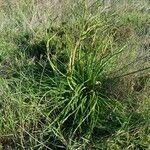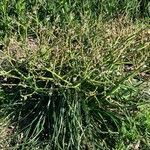Robust, tufted perennial herb. Leaves to 60 cm long and 8 mm wide, glabrous or irregularly papillose on margins, surrounded at base by tubular scales. Inflorescence to 70 cm long, divaricately branched; bracts membranous; flowers erect to spreading; pedicels not or scarcely articulate. Perianth segments to 14 mm long, white with a conspicuous green nerve and a yellow spot near base, shrinking around developing fruit, later deciduous but leaving a basal cup c. 0.5 mm deep. Stamens somewhat dimorphic, 2–3 mm shorter than perianth; outer whorl spreading; inner whorl connivent; anthers c. 1 mm long. Style ±equal to outer stamens; ovules 12 per locule. Capsule subglobose to ovoid, to 1 cm long. Seeds tetrahedral, c. 1.5 mm long, smooth.
Perennial, grass-like herb. Leaves linear, up to 1 m long, 4-12 mm wide, glabrous. Inflorescence divaricately-branched raceme, up to 0.5 m high, glabrous; pedicels 4-12 mm long. Flowers white with green keel, with yellow dot near base. Flowering time Aug., Sept. Fruit a globose, glabrous capsule.
Rhizomatous perennial, up to 0.9 m tall, stout, fleshy and smooth, roots slender. Leaves usually evergreen and shiny. Panicle stout, succulent, much branched with broad, white bracts. Capsule ellipsoidal, ± 10 mm long, held erect.
Like T. revoluta but stouter and glabrous, leaves somewhat fleshy and fruits larger, ± 10 mm long.
An onion like plant.


